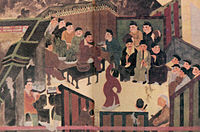
Fu (Chinese: 賦), variously translated as rhapsody or poetic exposition, is a form of Chinese rhymed prose that was the dominant literary form during the Han dynasty. Fu are poetic pieces in which an object, feeling, or subject is described and rhapsodized in exhaustive detail and from as many angles as possible. Classical fu composers attempted to use as wide a vocabulary as they could, and often included great numbers of rare and archaic terms in their compositions. Fu poems employ alternating rhyme and prose, varying line length, close alliteration, onomatopoeia, loose parallelism, and extensive cataloging of their topics.
Unlike the songs of the Classic of Poetry (Shijing) or the Verses of Chu (Chu ci), fu were meant to be recited aloud or chanted but not sung. The fu genre came into being around the 2nd and 3rd centuries BC and continued to be regularly used into the Song dynasty. Fu were used as grand praises for the imperial courts, palaces, and cities, but were also used to write "fu on things", in which any place, object, or feeling was rhapsodized in exhaustive detail. The largest collections of historical fu are the Selections of Refined Literature (Wen xuan), the Book of Han (Han shu), the New Songs from the Jade Terrace (Yutai xinyong), and official dynastic histories.
There is no counterpart or similar form to the fu genre in Western literature. During a large part of the twentieth century, fu poetry was harshly criticized by Chinese scholars as excessively ornate, lacking in real emotion, and ambiguous in its moral messages. Because of these historical associations, scholarship on fu poetry in China almost ceased entirely between 1949 and the end of the Cultural Revolution in 1976. Since then, study of fu has gradually returned to its previous level. (Full article...)